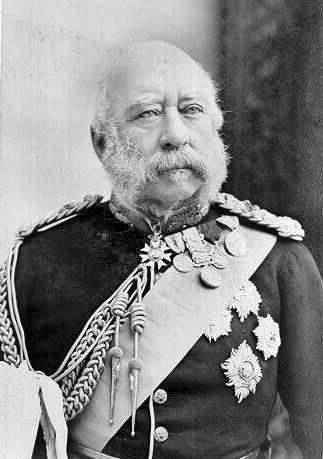
AT 9PM on Thursday October 8, 1846, 27-year-old Prince George, Colonel of the 17th Lancers, arrived in Limerick and took up residency in Pery Square. He was in the city to take command of the army in the Limerick district, passed over from Major-General Lord Downes.
At the time he was Prince George of Cambridge. Though four years later, following the death of his father Prince Adolphus (1774–1850), the seventh son of George III, he inherited the title of Duke of Cambridge.
In a fitting coincidence, the Georgian area of Limerick was named after George III, the young Prince’s grandfather.
He was accompanied in Limerick by his Aide-de-Camp, Captain MacDonald. MacDonald and the Prince had dinner with Colonel Mansel on their second night in the city. It was not all fine dining, he ate on several occasions in the mess rooms of the New Barracks (now Sarsfield Barracks) with the other military men.
The Prince was known as a patron of the arts. During his short time in Limerick one of the acts he supported arrived in the city. His patronage was noted on the advertisement for the ‘The Ethiopian Delineator’ concert at the Philosophical Rooms on Glentworth Street.
Tickets for this concert could be pre-booked at Corbett’s Music Warehouse, George M Goggin’s 34 George Street (now O’Connell Street), and on the door. The concert was under the direction of Richard Ward Pelham, a ‘blackface’ performer from New York.
Additionally, on October 26, he inspected the Artillery, 8th Hussars, and the Pensioners corps in the New Barracks. He noted that he was extremely pleased with the “manoeuvers and the noble appearance presented on the ground by the several corp”.
The following day he went to the Newcastle racecourse, where he inspected the 59th and 85th Regiments. Those regiments carried out a sham battle for the amusement of the Prince.
He left the Limerick garrison on October 29, 1846, to inspect the districts of Tralee and Ennis, this was only days after he was in Clonmel to inspect the troops there.

A journalist for the Kerry Evening Post, who met him in Kerry, noted that the Prince was “a fine soldier-like looking man, nearly six feet high, and presents the appearance of an older man than he is”. The journalist also noted that those who met him “speak highly of his general information and urbanity”.
While out in Newcastle West inspecting the troops there in early November, the Prince noted his delight at the “soldier-like appearance of the men, and also at the cleanliness and regularity of the barrack”.
The Prince also interacted with the local gentry. Henry Robert Addison remembered the young royal and MacDonald attending the County Club, where they played billiards. In mid-November 1846, the Prince “shot a lot of game in the preserves of Mountshannon” near Lough Derg.
A special service was arranged at the end of November 1846 in St Michael’s Catholic Church, Denmark Street, by Rev Mortimer Murrane in aid of Christian Brothers School. Although the Prince did not attend this service, he did donate £5 to the event through Rev Willian Bourke, St John’s Chapel. This was only matched by the sum raised by St Michael’s Total Abstinence Society.
The notable William Smith O’Brien MP donated £1. In total just under £133 was raised at the event by the Limerick elite society in 1846, with names such as Harvey, Honan, Howley, and Russell on the list.
However, the Prince did attend church services in Limerick. It was noted in the local press that he had attended a service in St Mary’s Cathedral on October 11. The Rev Thomas Westropp preached to a large crowd that day.
During this time, Limerick Lace was a prized commodity. It would become a favourite of the reigning monarch Queen Victoria. On December 1, the Prince visited Robert McClure’s lace factory on Brunswick Street (now Sarsfield Street). He was very impressed with the “order and regularity” of the business and the various items produced there. He then purchased several pieces of lace from John Robertson’s warehouse at 130 George Street. It is possible that he gifted some of this lace to his cousin, the Queen.
However, it was not only pleasure trips and viewing of soldiers that occupied the Prince’s time. On a dark Thursday afternoon on November 26, 1846, a fire broke out in one of the chimneys of Barrington’s Hospital.
The alarm was quickly raised and one of those quick to the scene was Prince George, accompanied by Colonel Mansel, a fire-engine of the Ordnance barracks, a section of the Royal Horse Artillery, and a detachment of the 8th Hussars. Despite their early arrival and large numbers, the young royal’s military was not needed. Two Royal Irish Constabulary constables from the Lock-Quay and the hospital’s resident apothecary (pharmacist) had made their way to the roof and were moving water from the tank, also situated on the roof, down the chimney until the flames were quenched.
It’s worth remembering that in 1846, Limerick and the surrounding area was seeing the impact of the Great Famine. The melancholic sight and distemper in the country may have been influential in the moving of the Prince.
On January 1, 1847, Major General Napier took over the role of commander of the Limerick district as Prince George returned to Dublin. Napier also took over the house in Pery Square where the Prince lived. Although it was only a short few months that the Prince was in Limerick, he managed to imbed himself into all aspects of society while here.
The Prince acted, for the majority of his professional career, as Commander-in-Chief of the Forces, the military head of the British Army. He was responsible for many notable changes, including the introduction of the Royal Military School of Music and removing the flogging of soldiers – except in cases of mutinous conduct during wartime.
Prince George was the 2nd Duke of Cambridge, and although he had three sons, they were barred from inheriting the title as his marriage had been in violation of the Royal Marriages Act 1772. The Prince married his mistress, actress Sarah Fairbrother, in secret only a few weeks after he left Limerick. She was pregnant with their third son at the time of the marriage. So, the title became extinct on the death of Prince George in 1904.
In 2011, the late Queen Elizabeth II reinstated the title of Duke of Cambridge, bestowing it on her grandson Prince William on his marriage to Kate Middleton.
For further reading on Limerick’s high society check out:
Henry Robert Addison, Recollections of an Irish Police Magistrate (1862).







